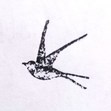Hûw Steer's Blog, page 8
August 24, 2024
Narratess Indie Sale 24-26th August
Once again, Many Indie Books are on sale; once again, one of mine lurks among them like some chittering demon. It’s Ad Luna this time. It’s free.
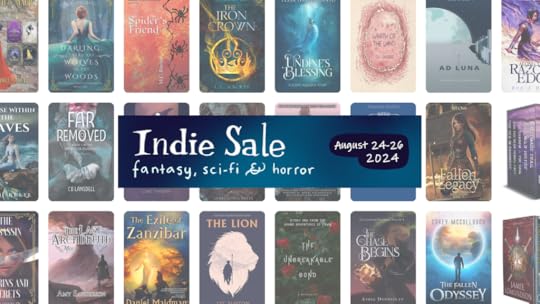
Look at all these books! Look at how many you could get! Do it. Buy books. Do it now.
(Ad Luna is also sneakily free until Tuesday the 27th too because why not.)
August 18, 2024
A Darkness Returns – So Does The Riftwar
Over a year ago, I made this observation:
Hang on.
An Interview with Raymond E. Feist (The Fantasy Review), February 7th, 2023
Feist: “Writers rarely retire unless circumstances require them too. I’m working on the 1st book of the DragonWar Saga, A Darkness Returns.”
A Darkness Returns.
Returns.
Well.
I’m going to need a bigger bookshelf.
Dear reader, to my incredible surprise, I was right.
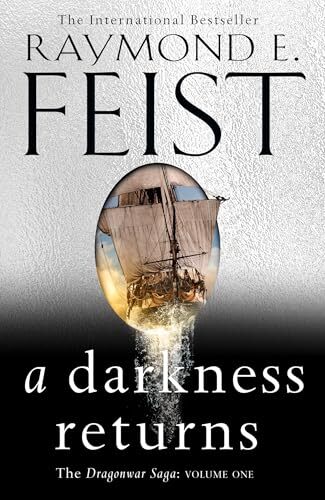
It’s a new Riftwar book. Sort of. It is also, apparently, a new Firemane book, a sequel to Feist’s other fantasy trilogy that he’s spent the last few years writing in the post-Riftwar period. It’s all the characters (well, all the surviving characters) teaming up to save both worlds against a nice new Big Darkness.
Now, on the face of it, this sounds like another creator succumbing to the Disney Urge: the comic-book approach of mashing all their characters together for the sake of it and hoping that the audience will feel obliged to get onboard. But unlike Disney desperately scrambling to fix the MCU by throwing money at Robert Downey Jr. (when they could have just recast Jonathan Majors as Kang, a character whose entire schtick is that he has an endless number of different variants, and I’ll stop here before this post becomes a Marvel rant), Feist’s little multiverse doesn’t feel unreasonable. The entire point of the Riftwar, the foundational principle of that sprawling series, is that multiple worlds collide. The original trilogy and the Empire trilogy were two different series repeatedly crossing over, back in the 1980s, and the series was always about multiple worlds. So why the hell not throw in another one? Why not link the Firemane books to the Riftwar? If your seminal series is about connecting different fantasy worlds, why not connect your own?
I’m certainly willing to give it a shot. But first, of course, I’ll need to read the Firemane saga, which I began doing literally seconds after walking out of Waterstones with A Darkness Returns clutched under my arm.
A continent at uneasy peace after a huge war braces for the next big conflict. A new and ominous religion exerts its dominance; barons dream of becoming kings; assassins sharpen their blades. The last son of the destroyed Firemane line begins to learn of his heritage. And a young blacksmith finds his place in the world is a bit more complicated than he’d first thought.
That’s the first book, King of Ashes, which I just finished.
It was ok.
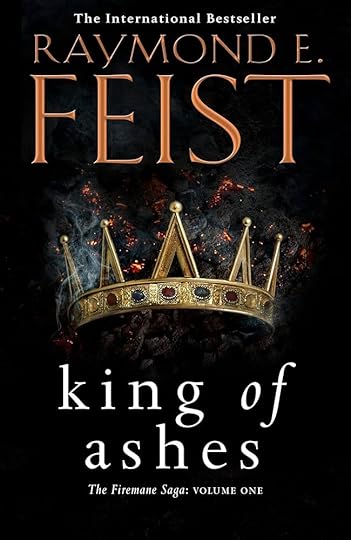
Don’t get me wrong: the world of Garn is well-constructed, with thought-out politics and geography, believable technological and social standards, and a nice sprinkling of cool magic stuff to spice things up. Declan the blacksmith could just make good swords… or he could make Magic Damascus Steel! Sailors could just deal with pirates… or there could be a hidden kingdom of evil merpeople waiting to abduct and enslave them!
But there’s a weird and clunkily delivered obsession with Sex and Murder and Horrible Crimes that just isn’t written with the emotional weight that it needs to be properly impactful. The prologue, setting up the end of the Big War, talks about the entire family of the defeated king being put to death, down to babies, in a way that just doesn’t feel comfortable for the writer. A disproportionate amount of the book is taken up with young Hatu – the last surviving Firemane, now a trainee assassin/rogue/whatever – having Teenage Sexual Feelings. We get it, Raymond. He’s a teenager. We don’t need three flashbacks in a row of him getting embarrassed over an erection, written in the same stilted manner.
There are a lot of aspects to this book that make me think Feist looked at how successful A Game of Thrones and that sort of grimdark fantasy was doing, thought ‘Yeah, I can do that’, and proceeded to… not do that very well. (Kingdoms at war? Political jockeying? Little magic remaining in the world, a focus on bastards, excessive sex and murder… yeah, it’s becoming more and more clear.) I appreciate the need for any author to try their hand at something different, especially after 30 books and 30+ years of the same series. But while King of Ashes definitely feels like a more mature and darker book, it also feels like bits of grimdark have just been thrown in (and poorly written) because Feist felt like they were supposed to be there.
But there’s a lot to like about this book. It’s a new, fleshed-out and thorough world, with some very strong concepts – the assassin nation of Coaltachin, the sinister Church of the One. I’m particularly enjoying the story of Declan the blacksmith: while the tendrils of the main plot are encircling him ever-tighter, his story is basically just about a young, skilled man making his way in a harsh world, and it’s very well realised. This is clearly a story that was planned as a trilogy and has only just begun, and I’m looking forward to reading the rest.
And then I can get back to Midkemia after all this time.
I’m a bit concerned that this crossover won’t work. I’m worried that blending the two worlds will either mean that the Riftwar characters get needlessly ‘grimmer’ in Feist’s currently-clunky way, or that the overall darker tone of the Firemane characters will be lost in the mix.
And I worry that adding in another world will take Feist’s attention away from the great setup he left at the end of Magician’s End for future Riftwar stories. I want to read about the “strange and alien life fashioned by wild magic” lurking in the bottom of the Big Crater; about Magnus guiding the worlds of Midkemia et al into a new and exciting future. I have a sinking suspicion that throwing the Firemane characters and world into the mix will mean that Feist entirely forgets about much of this setup in favour of blander Multiverse Stuff.
But at the end of the day… it’s Midkemia again. It’s Magnus, it’s Pug, it’s my favourite series continuing. Is it going to be good? Who knows. Am I going to read it? Absolutely.
August 11, 2024
Puzzles in Plain Sight
There are few things more satisfying than finding an easter egg – a hidden surprise, a secret message, something tucked away that can only be uncovered by solving a puzzle or leveraging knowledge you’ve already got. Escape rooms, videogames, even understanding oblique references in books (looking at you, Discworld) – there are many ways to do this and they’re all immensely fun to pull off.
But the ones that stick in my memory are the ones from when I was about 10: when Doctor Who was revived, and some brilliant people at the BBC decided to litter the Internet with tie-in websites crammed with little secrets.
There were a lot of these, and looking at the TARDIS Wiki I definitely don’t remember them all, but the ones I do recall have always stuck with me. In the days when just searching for something online wasn’t so ubiquitous and you had to actually figure stuff out for yourself, being rewarded for being a big nerd and remembering throwaway lines of dialogue was so very fulfilling. Because that’s what you needed to find these hidden things – not just to find the sites, but use information from the TV episodes to unlock the secrets within.
Take the UNIT website – a great impression of a fictional government website. So realistic, in fact, that it was the reason the United Nations sent the BBC a cease-and-desist order and forced them to change the organisation’s name from ‘United Nations Intelligence Taskforce’ to ‘Unified Intelligence Taskforce’ in case people got confused. Seriously.
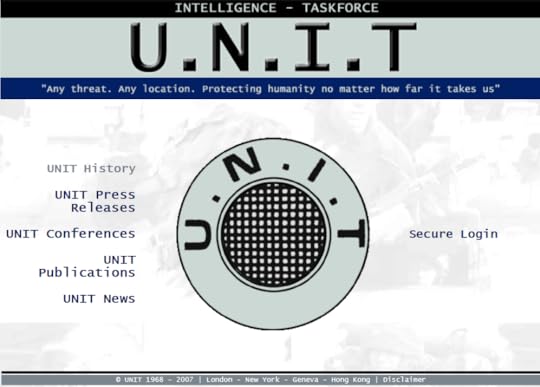
The site had some nice in-universe information about a perfectly ordinary branch of the British military. But what about that ‘Secure Login’ button, though? If only you were listening to the Doctor during World War Three and knew what the password was…
(Actually, that password – BUFFALO – only let you do as Mickey did in the episode and fire a little Flash ballistic missile. Getting to the juicy stuff required the password BADWOLF, which was more oblique but another obvious one to try for a young viewer at the time.)
And suddenly the screen goes red, new pages unlock, and there are dozens of secret press releases, updating mission reports for every new modern Earth-based story – including all the little details that the episode skips, like the casualty reports or the cover-up efforts. In short, all the little juicy details that good worldbuilding demands, even if they never make it to the screen or page.
The Geocomtex site gave you background for the episode Dalek – and while I can’t find evidence of this I could have sworn it was where you accessed the magnificent Flash game that was ‘The Last Dalek’. (Which I can’t find a fully working archived version of online, but the Flashpoint project has it in full.) The Torchwood website gave so many teasers for this mysterious organisation ahead of the Big Reveal of Army of Ghosts/Doomsday. This was absolutely addictive for a young fan of the show, especially in the pre-streaming days when we actually had to wait an entire week for more episodes to air.
The one I remember best, though was the Cybus Industries website – the evil corporation responsible for building the parallel universe Cybermen perfectly harmless tech company with their cool new headphones and futuristic (for 2006) outlook. The archived version alas lacks the old images, but when 10-year-old me found it, it looked like this:
 Ah yes, the headphones of the future.
Ah yes, the headphones of the future.Fictional product pages, interviews with the CEO – loads of little bits of expanded worldbuilding for the two Cyberman episodes, written just for the joy of viewers. But there was more – much more. Apparently – and because I was only 10, I missed this bit – there was a whole ARG, starting on the aforementioned ‘Defending the Earth’ site, where one was sent to ‘infiltrate’ Cybus, finding codes to unlock secret features on the site that were revealed when the actual episodes aired. I skipped this bit – but because I paid far too much attention, I remembered the appropriate codes when they were revealed on-screen, and so when prompted to enter BINARY9 on the ‘Staff Intranet’, the Airships game was revealed in all its glory.
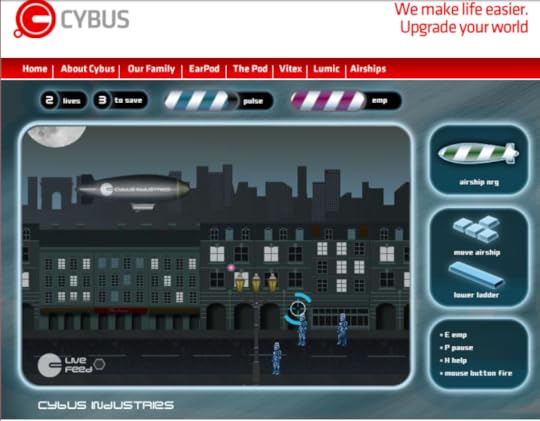
I hacked the Intranet! I broke into the evil corp and now I’m saving the world! Yes, I’m doing it in a 2D Flash game that’s freely available to everyone, but I found the thing! This wasn’t just worldbuilding, it was interactive worldbuilding, rewarding me and all my nerd friends for paying attention to the programme we loved.
I still love solving puzzles. I still love finding the little hidden things. I love writing them myself, too – and I do it a lot, even if it’s just sly references that I know only a couple of people will understand. But when a puzzle isn’t obviously a puzzle, when it’s hidden in plain sight, and when you realise that you already know the answer thanks to just doing what you already love… it’s just a wonderful feeling.
Do more of this, BBC. Kids around the world will love you for it.
August 4, 2024
Scientific Limitations of the Boiling Seas
The biggest issue I’ve encountered when building the world of this third book in the Boiling Seas is that almost nobody can tell me what boiling water looks like from the inside.
You’d think that in this age of crazy cameras and resistant materials that somebody would have thought to take a video inside a kettle – but, to date, I have only found a handful of examples. And while they do give me some information, it’s not enough. I’ve had to – shudder – make stuff up. In a fantasy book, of all places. Because The Owl and the Labyrinth requires my protagonists to just be hanging out underneath the Boiling Seas – so I need this description to be watertight in more ways than one.
And no, looking into a glass kettle is insufficient, damnit – I need to see a view from actually inside that bubbling, boiling water.
This was the first example I found, and while it does give me information, there’s a bloody egg in the way. What I do get from this, apart from notions of how my sailors need to cook their breakfast, is an insight into how those bubbles pool and move. It’s not quite like inside something carbonated, where bubbles cling to introduced objects – they’re leaping off that spoon as fast as they can even when it’s not moving. Boiling water is a dynamic place. (Good: that’s how I’d been writing it.)
From Make Sushi 1. They… mostly make sushi.There’s also this example from a hot spring in Sri Lanka – but a hot spring is not a boiling spring, and though it showcases the constant streams of bubbles very nicely it’s just not hot enough for what I need. This cameraperson stuck their hand into the water with no ill effects – if they did the same on the Boiling Seas they’d be on their way to hospital in seconds. But again, we see these rising bubbles, this time in great columns coming from the deeper heat source somewhere down there.
From This Generation.Hot springs are probably the closest real-world equivalent to the Boiling Seas that exist in the real world: water being heated by magma or other deep geothermal stuff, full of minerals and occasionally very much unsuited to casual swimming. But because rocks, they seldom appear to be convenient deep shafts of water – while there is footage from inside some of the geysers at Yellowstone it’s largely of wet rocks rather than an actual view of inside the water. The geysers we have easy access to are on land, and so decidedly less damp than something at the bottom of an entire boiling ocean. No pockets of ‘dry’ space down there – it’s all water, all bubbling, all the time.
But if relatively little magma can produce effects like that… how hot is the ocean floor of the Boiling Seas? How tortured is the surface of this planet? It’s a good thing most people live on islands because those plate tectonics are going to be serious. I wonder how it’ll affect people even on the mainlands, to have the seafloor in such constant flux, unveiling new chasms down to the searing magma of the planetary mantle. I gave Tal, Max and Lily a glimpse of that already, in Nightingale’s Sword. But that was under the land. Under the sea? That’s another sight entirely.
So while resources are limited I have some picture of what the underwater world of the Boiling Seas should look like. Apart from all the metal fish, of course. But the actual water I have some picture of… but not enough. Research for fantasy stories can inevitably only get one so far before you have to make stuff up – that’s the whole point of the genre – but I was surprised how little real-world info I was able to find to start things off. That’s the author’s life, though, I suppose.
If anyone reading this happens to have a kettle, a heat-resistant and waterproof camera, and spare time on their hands, I’d love to hear from you. Bit of a specific request, but you never know, eh?
July 28, 2024
The Waiting Game
Writing is a waiting game, in so many ways. You wait for ideas, you wait for artwork, you wait for readers, you wait for reviews. You wait for sales, for any indication that people have actually read what you’ve thrown out into the world.
And most of all you wait for submissions. You wait for feedback on them. You wait, often, for any indication they’ve been seen at all. And you wait a long time.
I’ve been querying my various books with literary agents for many years now. As you will no doubt have noticed from my conspicuous lack of shouting it from the rooftops, I have yet to encounter success.
And that’s fine. Without a hint of sarcasm, that’s genuinely fine. This is a long game as well as a waiting game – I know that very well. It took me years to even get a short story out, let alone a piece of longer work, and though I’ve achieved a vague level of consistency on that front in the last year or two I know it could easily be a blip. Creative recognition takes time. That’s what we all sign up for when we start this writing lark. And when something does slip through and get accepted it’s one hell of a feeling.
But agent submissions, full queries like the ones I’ve been making myself get back into sending out, are a different kind of waiting. It might take a while for a magazine editor to send back a form rejection, but they usually get there in the end. And, being short stories, the work of sending one out again to somebody else doesn’t take that long.
Agent queries are like job applications. You research who’s open for submissions, you research their tastes. If they might – might – be right for your book, then you figure out how much of it they actually want to read as a sample. You edit extracts. You put together a synopsis, a covering letter that goes into what feels like nauseating detail. You throw all of this out when you realise that their website has a submission form instead of an email address. It can take hours just to get something ready to throw in front of an agent’s eyes.
And then you sit back and wait. Sometimes for months. If you’re incredibly lucky, sometimes for days. For a form rejection, yes, but at least it’s something. Or, as has been the case for me, you wait for over a year and hear precisely nothing.
 My current QueryTracker list. Blue is recent submissions, red is actual rejections, and pink is submissions so old that the website is telling me to give up hope.
My current QueryTracker list. Blue is recent submissions, red is actual rejections, and pink is submissions so old that the website is telling me to give up hope.Agents are busy. Of course they are. There’s a reason they all state multi-month response times, and it’s because there are a thousand people in exactly the same situation as me, with exactly the same hopes and frustrations, hurling submissions at them every day. Slush piles totter like skyscrapers on desks across the world. I understand. I sympathise. I remain frustrated beyond belief.
Because a rejection is, while disappointing, fine. It’s a conclusion, even if one you don’t want. It tells you to move on to the next attempt. Silence, on the other hand, has no closure. These unanswered submissions – and unanswered follow-ups, and follow-ups to follow-ups – sit in my emails like lead weights. I may as well have dropped my manuscript in a well: at least I’d hear a splash when it hit the bottom.
But long after any stated or reasonable window has closed, I still sit and stare and wonder. Sometimes things fall through the cracks, after all. Occasionally I’ll actually get a response, a year later, to an ancient query to that effect, and even though it’s a form rejection at least it’s got a personal apology appended to it. Never mind ‘no news is good news’ – bad news is at least news.
I keep going. I keep submitting. I add more names to the pile and wait to see what flavour of news I’ll receive. I don’t mind which, honestly. Anything will do.
But I keep going, because this is a long game and I’m in it until the end. Because that’s what writing is. That’s what stories are. They keep going until they’re finished being told, and I am certainly not finished yet.
July 21, 2024
What Am I Doing: July 2024 Edition
How much storytelling mileage can one get out of a joke? Answer: at least 6000 words and I’m probably not even halfway through yet.
I’ve had a bit of a break from Boiling Seas 3 editing for the last couple of weeks – largely because while my rewrite of one plotline is going swimmingly, I really need to insert and adjust the other half of the story before I get too far into things. Ideally I want two mini-climaxes to line up with each other for Maximum Excitement, similar to the various airship fights in Nightingale’s Sword, so I need to make sure one half isn’t too much longer than the other or I’ll have to start actively adding filler instead of just accidentally writing far too much like I normally do.
So that’s a chunk of writing and editing that I really need to dedicate a day or two to, rather than just doing it in the morning before work. First-thing writing is perfectly fine to just create, I find – I can get some really good words down, and have been doing so every day for the last… almost 10 years? Wow. But when I’m editing I need to engage my brain on a more conscious level rather than just going with the flow. And as my brain is currently engaged with wedding planning and the assorted life admin involved, I haven’t found a moment for said editing day just yet.
Therefore, Silly Story. A Silly Story which has actually gotten fairly serious in the telling, even as I work from a premise that is little more than a stupid pun. It’s fantasy, loosely, and in a departure from my normal output it’s largely a legal drama. (Despite this being the central essence of the starting joke I didn’t anticipate quite how much actual court-case I would have to write; the legal system of this story may not end up bearing up to much scrutiny. Thankfully, it’s not meant to be fair…)
It might end up a bit too contrived for proper publication but I’ll at least let you lot read it. I also started another short, but this one actually requires some thinking to make proper sense so again I’ve set it aside for now.
I’ve had to do a lot more creative palate-cleansing with this book than I normally would, and it might be because the narrative is complex but it’s probably a lot more to do with the rest of life. I’ve got a lot on. Shorter, simpler stories sit better with my brain right now. It’s times like these that I really should look back at my children’s stories and see what else I can put together on that front… but I can’t let myself get distracted with a different book. Short stories are one thing, a whole other novel (even a novella) is quite another.
I anticipate having a lot more creative brain-space, and brain-space in general, after the end of August. Funnily enough one’s wedding takes up a lot of one’s attention. But the Boiling Seas are never far from my mind, and I just have to make sure I remember to write down all the mad little extra ideas I keep thinking of on my walks to work. That’s how I worked in magic hoverboards, after all.
And several of the extant tasks on my wedding list are literary in nature, in fairness. And I’m not even talking about my speech.
Though I should also write my speech. I really should write my speech.
July 14, 2024
Review/Ramble – Red Mars, Green Mars, Blue Mars
It may seem to you, dear readers, that I’ve been on a bit of a Mars kick for a while now, what with Great Martian Railways coming out and the many rambling posts I’ve made about it and related Stuff About Space. But there is another reason for this mild obsession, and its name is Kim Stanley Robinson.
Ok, its name is actually the Mars Trilogy: Red Mars, Green Mars, Blue Mars; three absolute doorstops of books that cover, in detail, a colonisation and terraforming of Mars over the course of centuries. This trilogy is unquestionably epic, in all senses of the word. From their landing on the Red Planet to their first settlements, to building space elevators, full multi-national colonisation and the ensuing wars between these Earthly interlopers and the descendants of the older settlers – the first native Martians – the story of Robinson’s Mars is incredible in scope.
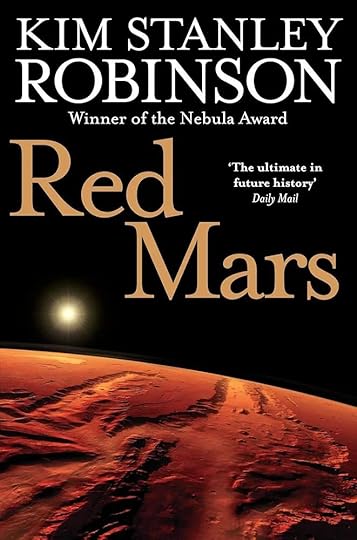
It is simultaneously multi-generational, taking place over centuries, and not, thanks to convenient immortality treatments that arise by the end of book 1, which means we get to experience Mars through both the eyes of those born into it, newly arrived outsiders, and those First Hundred, the original, immortal settlers who see Mars change from its barren state into a world fit for humanity… or not. This is a really interesting POV approach, honestly – a bit best of both worlds in how it showcases the changing attitudes towards a changing planet. And Robinson even squeezes in a bit of ‘the impact of immortality on an ordinary human brain’ just to cap things off nicely.
These are dense books. A dozen or more POV characters, each with their own chunks of narrative – though only switching after big sections, and always interacting with the other characters along the way, so nobody feels isolated and everyone gets room to breathe and explore their viewpoint. Almost too much room, sometimes – it does lead to long sections where the more interesting plot points get parked as characters explore other aspects of Martian life – but almost invariably I then find myself annoyed as I’m torn away from their story to jump to another thread.
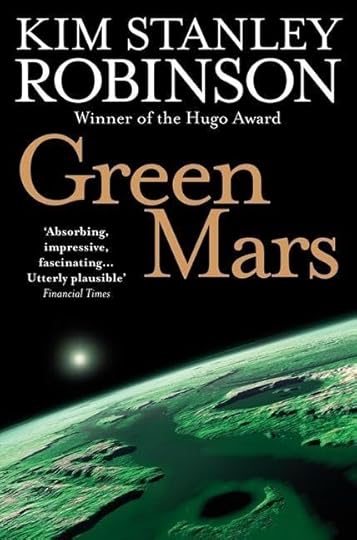
But the density is what makes these books so impressive, honestly – because Robinson has thought of everything. I really mean that. Though advanced tech gets things off the ground a bit quicker, every development in habitation, in terraforming, in technology, is meticulously explored. Because there are so many characters with so many specialisms we jump from intense microbiology to advanced materials science in the blink of an eye, and every aspect phenomenally well researched. Seriously – Robinson is writing about nitrogen fixing, about weather patterns, about soil composition on another bloody planet and nailing it every time.
Just about the only thing he doesn’t cover in detail is public transport. There are trains, but how do they run? How were those rails laid? Checkmate, Robinson!
Seriously, though. The technical explanations and the level of detail can get a bit daunting, but these books may as well be a future documentary waiting to happen. The sheer vision needed to imagine a world in this much detail is only matched by the vision of Robinson’s characters as they build that world for themselves. If NASA appointed Kim Stanley Robinson the head of their Mars programme I would not bat an eyelid. In everything he writes, he seems to know more than anyone else alive.
And the politics. It’s not just the science of terraforming Mars, it’s the phenomenal insight into how humanity would actually react to this – how a changing world would treat the changing of another world. There are factions, there is rampant capitalism, there are climate crises and corrupt politicians, all frighteningly real, honestly. This is not a utopian vision of a new world – it is a very realistic look at how humanity will inevitably do its best to squander the opportunity that a new Mars would bring.
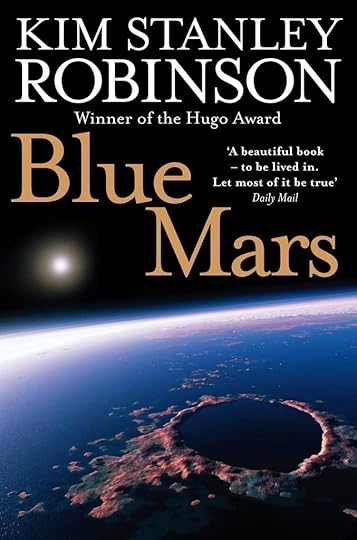
I haven’t actually finished Blue Mars yet – if I wait to write this post until then it’ll be weeks away, these are big books – but I am so immersed in how this story is playing out. I wonder just how he’s going to end it. All this time, all this work, and humanity is still just taking steps towards creating a Mars they can truly live on. It’s the kind of story that doesn’t really have an ultimate ending, because it is the future, or may as well be. And all the future does is keep on changing, forever just out of our reach.
July 7, 2024
Sequel Shorts
The thing about short stories is that they are, by their nature, self-contained.
Good short stories, or at least the kind of short stories that people will read and therefore the kind that stand a chance of someone wanting to publish them, are complete. They’re a whole plot crammed into a short word count, with beginning, middle, ending, characters – the whole shebang. You can pick up an anthology or magazine and get the full story experience from each featured author.
And unless you’re publishing your own anthology, this is necessary. Readers of a literary magazine or anthology are, as a general rule, going to see this one example of your work and that’s it. Your work needs to stand alone and stand alone well: no big dangling threads, no unsatisfying conclusions. It’s not an extract of a larger work, it’s a work in its own right – and as such it almost always needs to be a complete, one-off experience.
Well. Almost always.
I’m not talking about authors like Andrzej Sapkowski, who slot all their short stories together and turn them into full novels, or those who put together whole anthologies of their own, semi-related works. I’m talking about just writing a sequel. A second short story in the same universe as a previously published one, following the same characters or the same environment. It doesn’t get done often these days, and for the core good reason that if you write a follow-up story and get it published, there is no guarantee any reader will have read the first one.
In your own anthology or publication, that’s not a problem – the first instalment can simply be placed on the preceding page. If you’re a regular writer for a more specialist publication, like White Dwarf or the Black Library in general, then your odds are better too: your audience is going to be more specialist and more likely to have read earlier instalments too. But even then, you can’t just write a sequel in the way one might write a sequel book. If you write ‘Book 2’ on the spine then people are going to look for Book 1 first. If it’s a standalone short, they’re far less likely to know – especially if this is their first dip into your universe.
To mention Warhammer 40k again: Dan Abnett has written many a short story for his Inquisition series, short adventures set between the main books, and he writes them exactly how this sort of story should be written: completely standalone. If you’re already a fan of the series then you’ll get much more out of them, because you’ll know what’s going on – but there are only one or two I can think of that wouldn’t make sense, by and large, as somebody’s first read. (And those ones were written specifically for omnibus editions of the books to fill in gaps, so that’s excusable.) You can pick up ‘Missing In Action’ or ‘Backcloth for a Crown Additional’ and just enjoy them as space detective stories in their own right, no matter which of the several anthologies they’re printed in you’ve bought. They tie into a larger narrative but without needing the rest of that narrative to work.
But if, like me, you lack the degree of support that one of the Black Library’s star authors has to work with – if you’re beholden to individual submissions to individual magazines, if you’re on your own – then how does one write a sequel or expansion to an existing short story?
For the most part, you don’t. And if you do, you approach things very carefully. I cannot assume that anyone has read my previous work. I have to assume the opposite, in fact. Pretty much everything I write – with the exception of deliberately marketed series stuff like the Boiling Seas – has to be a gateway into my writing. It must stand on its own and do so well if I want to have a hope of enticing a reader to pick up something else I’ve written. Which I do, very much. That’s half the point of doing any of this.
So when I have several actually quite good ideas for a sequel to a story I’ve already written – which I have – I’m going to have to go about writing them properly. Even if they are sequels in terms of plot, they can’t be sequels that rely on reading the first story. They need their own hooks, their own complete plots from start to finish. If a character shows up for a second time then they need their own full introduction within the story, or at least one that doesn’t rely on reading the last one. A little reference here and there is fine – but they can’t be essential.
But of course I can’t just rehash the same introductions as before, because if a reader who has read the previous story comes along, I need to provide them with a fresh experience. I can’t restate all the same technobabble that’s already been established – I need new ways to approach the older things. I have to balance accessibility for new readers with innovation for the old ones.
Even if one of these stories were to end up in the same publication as the previous instalment, there’s no guarantee anyone will remember the first one, especially how long ago it will have been published. If they even get published. But there’s never any sense wasting time worrying about that when I could be spending that time writing.
In short: writing a sequel short like this is a massive challenge, with perhaps even less guarantee of success than writing already has.
I can’t wait to get started.
After all, either I find success and the standalones find their own homes and their own readers, or in a few years’ time I just slap them all together, write down the implied connective tissue to string them into one narrative, and I’ve got myself another novel. Win-win!
Now if you’ll excuse me, I have to once again Research some Science to see if this idea would even work…
June 30, 2024
Space for Inspiration
I’ve talked many times about how drawing on your real environment is a great way to get inspiration for storytelling. You need those experiences of the fresh wind in your hair, the sight of towering castle walls, the way light plays off a flowing river, to be able to truly capture those things in words.
So what the hell do you do when you’re writing sci-fi?
Because while we’d all like to, there are very few people who have actually been to space, who have those same lived experiences of what they would be writing about. You need other means of inspiration for subjects and settings like that. You need data. Images, footage, the sort of thing you can’t really whip up at home – even if you’re out in the back garden with a telescope, seeing distant worlds isn’t the same as setting foot on them, in the way that you can if you’re writing about more terrestrial environments. Not that terrestrial environments can’t feel alien, of course – where would science-fiction be without the gravel quarries of Wales, or the canyons of Morocco that I’ve walked, and then tweaked, myself for stories. But sometimes you need a better look, provided by better experts.
Happily for we poor SF writers, the actual scientists of the world are generous with their findings. Pretty much everything NASA finds is made public, from images to raw data. If you need specific stuff to back up an idea you’ve already had then you can peruse the photos from Hubble or the James Webb at your leisure. I’ve done this before and I’ll certainly do it again.
But if you just need general inspiration, or to get in the mood, then there’s only one place to go. APOD.
 Here be dragons. Space dragons.
Here be dragons. Space dragons.Protostellar Outflows in Serpens
Image Credit: NASA, ESA, CSA, STScI, Klaus Pontoppidan (NASA-JPL), Joel Green (STScI)
NASA’s Astronomy Picture Of the Day has been going since 1995, and the only thing that’s really changed about it since is the quality of the images they post. Every day, a new astronomical image or video is posted and explained in the perfect level of everyman’s detail, with external links and tangents galore. Every day, a new phenomenon, from nebulae light years away to the phases of the moon, all presented simply and effectively.
 The image from the day I was born in 1995. Space telescopes have come a long way since then, haven’t they?
The image from the day I was born in 1995. Space telescopes have come a long way since then, haven’t they?M1: Polarization of the Crab
Credit: Hale 5 Meter Telescope
Copyright: AATB, Caltech, David Malin, Jay Pasachoff
It’s a brilliant thing for anyone even slightly interested in space. There’s so bloody much of it, after all, that there are millions of things out there that you’ll never have seen or heard of – but APOD can bring one right to you every day. For me it’s absolutely perfect. Just taking a few minutes every morning to experience a bit of space, to let my mind be among the stars, is great. The sheer number of ideas I get from reading about these crazy celestial phenomena is even better. That nebula looks like a dragon! How do comets work? What the hell is a runaway star and how can I immediately write a story about one, please?
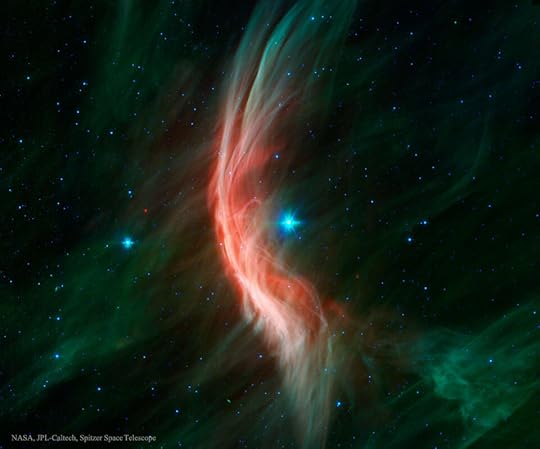 I might have a piece in need of trimming and wrapping up…
I might have a piece in need of trimming and wrapping up…Zeta Oph: Runaway Star
Image Credit: NASA, JPL-Caltech, Spitzer Space Telescope
I first discovered APOD years ago, and while I looked at it every day, at some point I got distracted by life and it fell by the wayside. Then I found it again, and it’s become a little highlight of my morning routine. Get up, eat something, get ready to write – and, just for a few minutes, go to space.
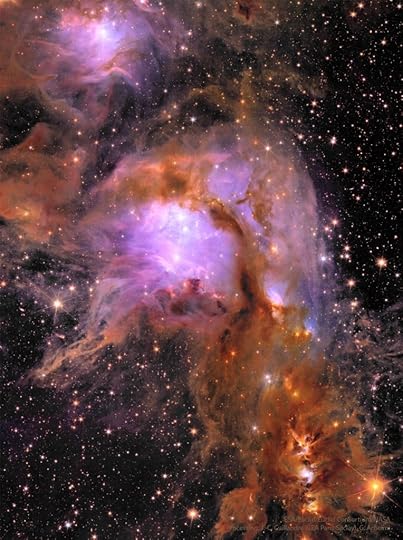 M78 from the Euclid Space Telescope
M78 from the Euclid Space Telescope
Image Credit & License: ESA, Euclid, Euclid Consortium, NASA; Processing: J.-C. Cuillandre (CEA Paris-Saclay), G. Anselmi
All the wonders of the universe, delivered right to your eyes, a day at a time. Who can say no to that?
All the above images are the property and copyright of NASA and the credited photographers.

